Freiburg im Breisgau
Freiburg im Breisgau (Alemannic Friburg im Brisgau, [![]()
![]() ˈfʁiːb̥əɡ̊]; abbreviated Freiburg i. Br. or Freiburg i. B. ) is a district-free large city in Baden-Württemberg, Germany. From 1945 until the founding of the state of Baden-Württemberg on 25 April 1952, Freiburg im Breisgau was the capital of the state of Baden. The southernmost large city in Germany is the seat of the Freiburg Regional Council as well as the Regional Association of the Southern Upper Rhine and the district of Breisgau-Hochschwarzwald. It is almost completely surrounded by this administrative district, of which it is not itself a member; as an independent city, Freiburg forms an urban district.
ˈfʁiːb̥əɡ̊]; abbreviated Freiburg i. Br. or Freiburg i. B. ) is a district-free large city in Baden-Württemberg, Germany. From 1945 until the founding of the state of Baden-Württemberg on 25 April 1952, Freiburg im Breisgau was the capital of the state of Baden. The southernmost large city in Germany is the seat of the Freiburg Regional Council as well as the Regional Association of the Southern Upper Rhine and the district of Breisgau-Hochschwarzwald. It is almost completely surrounded by this administrative district, of which it is not itself a member; as an independent city, Freiburg forms an urban district.
Currently, Freiburg, located on the river Dreisam, has 231,195 inhabitants (as of December 31, 2019) and thus ranks fourth on the list of the largest cities in Baden-Württemberg after Stuttgart, Karlsruhe and Mannheim. According to the OECD, the population of the Freiburg region ("metropolitan area") (including the districts of Breisgau-Hochschwarzwald and Emmendingen) was already 656,753 in 2018. It is located in the trinational metropolitan region of the Upper Rhine with approximately six million inhabitants. Due to its environmental activities, the city has been adorning and marketing itself with the title "Green City" since 2008.
The old town, just one square kilometre in size, with its landmarks - especially the Minster and the Bächle - is the destination of over three million visitors every year.
With the Albert Ludwig University founded in 1457, Freiburg is one of the classic German university cities.

View from the Schlossberg tower to Freiburg, at sunset

Aerial view of Freiburg from northwest to southeast
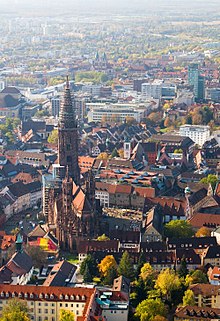
Freiburg seen from the Schlossberg tower, in the foreground the Freiburg cathedral
Geography

enlarge and show information about the picture
![]()
360° panorama of Freiburg im Breisgau seen from the Schlossberg tower. The elevations in the background are Feldberg (1), Schwarzkopf (2), Rehagkopf (3), Bleichendobelkopf (4), Brombergkopf (5), Illenberg (6), Kreuzkopf (7), Schönberg (8), Lorettoberg (9), Tuniberg (10), Kaiserstuhl (11), Uhlberg (12) and Roßkopf (13).
Geographical location
Freiburg is located in the southwest of Baden-Württemberg on the southeastern edge of the Upper Rhine Graben as well as largely in the Freiburger Bucht and at the western foot of the Black Forest. The nearest major cities are: Mulhouse (French: Mulhouse) in Alsace, about 46 kilometres southwest as the crow flies; Basel, about 51 kilometres south; Strasbourg, about 66 kilometres north; Zurich, about 85 kilometres southeast; Karlsruhe, about 120 kilometres north; and Stuttgart, about 133 kilometres northeast of Freiburg. The Dreisam flows through Freiburg.
The extension of the city in north-south direction is 18.6 kilometers, in east-west direction 20 kilometers. From the municipal boundary to the border with France it is 3 kilometres and to the Swiss border 42 kilometres. Freiburg has an altitude difference of over 1000 meters, from Waltershofen 196 m above sea level to the Schauinsland 1284 m above sea level.
The street name "Auf der Zinnen" reminds of the former city wall of the town. About 200 meters north of it runs the 48th northern parallel. The point is highlighted on both sides of the north-south thoroughfare, which is called Habsburgerstraße here, by writing in cobblestones of different colors, so that the latitude can be recognized.
Neighboring communities
The following towns and municipalities border the city of Freiburg; they are named clockwise, starting in the north, and are all in the district of Breisgau-Hochschwarzwald, except Vörstetten, which belongs to the district of Emmendingen: Vörstetten, Gundelfingen, Glottertal, Stegen, Kirchzarten, Oberried (Breisgau), Münstertal/Schwarzwald, Bollschweil, Horben, Au (Breisgau), Merzhausen, Ebringen, Schallstadt, Bad Krozingen, Breisach am Rhein, Merdingen, Gottenheim, Umkirch and March.
Geology
Freiburg lies on the border between the Black Forest and the Upper Rhine Graben. This elongated fault runs through the middle of the city area. The eastern districts lie in a valley connecting to the Zarten basin between the mountains Roßkopf in the north and Brombergkopf in the south. The southern districts of Kappel and Günterstal are already in the Black Forest. The Schlossberg, a foothill of the Vorberg zone, juts out like a nose directly into the inner city area. The rock below the so-called Greifenegg-Schlössle and in the western area of the Augustinerweg was quarried for the construction of the high medieval city wall.
With the southeast located 1284 meters high Schauinsland, the summit of one of the highest mountains in the Black Forest belongs to the Freiburg city area. With more than 1000 meters, Freiburg is among the major German cities the one with the greatest difference in altitude within the urban area. The western parts of the city are largely situated on an alluvial cone, which was formed during the last ice age. In the south lies the Schönberg, which belongs to the Vorberg zone, a part of the ancient mountain range, and which only partially slid away during the collapse of the Upper Rhine Graben.
Nature Conservation
The following seven nature reserves exist in the city of Freiburg. This means that 593.1 hectares of the city area are under nature protection, which is 3.85 percent, see also List of nature reserves in Freiburg im Breisgau.
- Arlesheimer See: 22.8 ha; Tiengen district
- Freiburger Rieselfeld: 257.0 ha; municipalities Mundenhof, Rieselfeld, Opfingen and Waltershofen
- Gaisenmoos: 25.5 ha; district of Tiengen
- Honigbuck: 7.5 ha; district of Sankt Georgen
- Humbrühl-Rohrmatten: 25.8 ha (of which 21.0 ha in the urban area of Freiburg); Waltershofen district
- Mühlmatten: 39.0 ha (of which 19.6 ha in the city of Freiburg); Hochdorf district
- Schauinsland: 1053.9 ha (of which 239.7 ha in the city of Freiburg); Günterstal and Kappel districts
In addition to these nature reserves, there are also landscape protection areas, see also list of landscape protection areas in Freiburg im Breisgau. In the past decades, the municipal, official nature conservation could partly not fulfil all objectives of the municipal protected area ordinances. Freiburg has had a tree protection statute since 1997. Nevertheless, disputes about the felling of trees occur time and again.
Climate
Freiburg is located in a zone with a warm and humid temperate climate, although there are great differences: The plains are warmer and drier, while the mountain zones tend to be cooler and wetter. With a mean average temperature of 11.4 °C, Freiburg is one of the warmest major cities in Germany. During the heat wave of 2003, for example, an official temperature of 40.2 degrees was measured on August 13. This was for a long time the second highest temperature ever recorded in Germany. The average annual mean temperature has increased from 9.7 °C to 11.4 °C since the 1961-1990 reference period (1981-2010 reference period), and even to 11.8 °C in the 1990-2018 reference period.
| Freiburg i. Br. | ||||||||||||||||||||||||||||||||||||||||||||||||
| Climate diagram | ||||||||||||||||||||||||||||||||||||||||||||||||
| ||||||||||||||||||||||||||||||||||||||||||||||||
| Monthly average temperatures and precipitation for Freiburg i. Br.
Source: DWD, data: 2015-2020 | |||||||||||||||||||||||||||||||||||||||||||||||||||||||||||||||||||||||||||||||||||||||||||||||||||||||||||||||||||||||||||||||||||||||||||||||||||||||||||||||||||||||||||||||||||||||||||||||||||||||||||||||||||||||||||||||||||||||||||||
The average annual precipitation of 837 mm is barely higher than the long-term German average of a good 800 mm. Most precipitation falls in the summer months of May to August with a peak of 107 mm in June. The lowest precipitation falls in February with 50.6 mm.
Freiburg is the location of the Center for Medical-Meteorological Research of the German Weather Service. In 2018, the latter opened the fifth of a total of ten urban climate stations planned in Germany at its site at Stefan-Meier-Str. 4 in order to obtain readings of the densely built-up cities in which more than 70 percent of the population lives and works. Compared to the measuring station at the Freiburg airfield, the temperatures here can be up to 10 °C higher. The aim is to better react to climate change. The aim is to respond better to climate change.
A speciality of the city's summer climate is the "Höllentäler", named after the Höllental valley to the east. Some time after dark, the mountain wind from the heights of the Black Forest ventilates parts of the city with great regularity. According to weather experts such as Jörg Kachelmann or Hans von Rudloff, this wind is not cool, as often assumed and often felt, but rather foehn-like warm. The downdraft wind is therefore said to give the city the most tropical nights in Germany with temperatures consistently above 20 °C.
City breakdown
See also: List of places in Freiburg im Breisgau
Freiburg has 28 districts, which are divided into 42 boroughs mainly for statistical purposes. In the districts of Ebnet, Hochdorf, Kappel, Lehen, Munzingen, Opfingen, Tiengen and Waltershofen, which were incorporated during the district reform of the former county of Freiburg, the local constitution was introduced. Thus these places received a local council to be elected by the citizens of the locality at the same time as the municipal council with a local head at the top as well as a local administration. The local councils are to be heard on all important matters affecting the locality. However, the final decision on a measure is incumbent upon the municipal council of the entire city of Freiburg.
The districts in detail (with order number):
| Middle
North
| East
South
| West
| Southwest
|

Topographic map of Freiburg
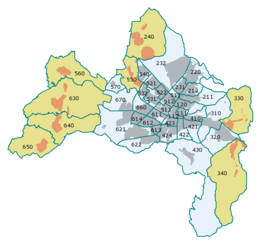
The boroughs of Freiburg with their official numbers (still without Vauban); boroughs with township constitution in beige
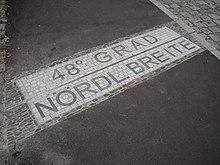
The 48th parallel as a mosaic pavement
History
→ Main article: History of the city of Freiburg im Breisgau
The first centuries after the foundation of the city
The first mention of settlements in the area of today's Freiburg, Wiehre, Zähringen and Herdern, is found in a document from 1008. Around 1091, the Zähringer Duke Bertold II built the Castrum de Friburch (Leopoldsburg ruins) on the Schlossberg. The settlement of servants and craftsmen at the foot of the mountain was granted market and town rights by Bertold's son Konrad in 1120. In place of the church, which had become too small in the meantime, Bertold V ordered the generous construction of today's cathedral around 1200, which was mainly financed by the income from the silver mines in the Black Forest, which contributed significantly to the prosperity of the citizens of Freiburg.
After the extinction of the Zähringers, the Counts of Urach took over the rule in 1218 and henceforth called themselves the Counts of Freiburg. After frequent disputes with the counts over finances, the citizens of Freiburg bought themselves out of the rule of the unloved Egino III in 1368 with 15,000 marks of silver and placed themselves under the protection of the House of Habsburg.
Fribourg had to provide warriors and financial aid to the new rulers. In the Battle of Sempach, the Swiss Confederates won against the Austrian Duke Leopold III in 1386, wiping out most of the Fribourg nobility. The guilds then dominated the city council. Fribourg was an imperial city until 1427. As lord of the Austrian Vorlande, Archduke Albrecht founded the University of Fribourg in 1457.
Counter-Reformation and Thirty Years' War
In 1498 Maximilian I held the Imperial Diet in Freiburg. Under the sign of the Bundschuh, the peasants of the Upper Rhine rose up in the same period, but the uprising near Freiburg under Joß Fritz in 1513 was betrayed. In 1525, in the German Peasants' War, peasants led by Hans Müller took Freiburg and forced the city council to join an evangelical Christian union. When the iconoclasts imposed Protestantism in Basel in 1529, the Prince of Science Erasmus of Rotterdam and the Basel cathedral chapter fled to Catholic Freiburg. With the completion of the high choir, which was consecrated by the auxiliary bishop of Constance in 1513, the cathedral was finally finished in 1536.
Shortly after the beginning of the Thirty Years' War in 1620, the Jesuits took over the University of Freiburg. In 1632 the Swedes under General Horn occupied the city, which changed hands several times in the following years. An Imperial Bavarian army under Generals Franz von Mercy and Jan van Werth took Freiburg in 1644. This was followed by the Battle of Freiburg between the Bavarians and Franco-Weimar troops.
Conflicts with France and Napoleon's rule
In the second half of the 17th century, under Louis XIV, there were repeated incursions into territory on the right bank of the Rhine. After the Dutch War, Emperor Leopold I had to surrender the city of Freiburg together with its fiefs as well as Betzenhausen and Kirchzarten to the French crown in the Peace of Nijmegen in 1679. After Louis XIV had instructed Sébastien Le Prestre de Vauban to develop the city into a modern fortress, the king visited Freiburg in 1681 to inspect the progress of the work in person. He stayed overnight at the court of Basel. In the Peace of Rijswijk in 1697, Louis XIV was allowed to keep the territories occupied in Alsace, including the free imperial city of Strasbourg, but had to return Freiburg to the Habsburgs. Towards the end of the War of the Spanish Succession, Marshal Claude-Louis-Hector de Villars occupied Freiburg again in 1713. In the second War of the Austrian Succession, the French under Marshal François de Franquetot defeated the Austrians at Weißenburg on July 5, 1744, besieged Freiburg, and were finally able to capture the city. When the French troops had to evacuate Freiburg, they thoroughly destroyed the fortifications. Only the Breisach Gate remained as part of the Vauban buildings.
French revolutionary troops captured Freiburg in 1796. After three months, Archduke Charles liberated the city. When the Duke of Modena Hercules III lost his Italian possessions in the Peace of Campo Formio in 1797, he received the Breisgau as compensation four years later in the Peace of Lunéville in 1801. Hercules III did not agree to this exchange, as he did not consider his losses sufficiently compensated. Therefore, he did not seek out Breisgau after 1801. The affairs of state were conducted by Baron Hermann von Greiffenegg, who did not formally take possession of Breisgau for the House of Este until March 2, 1803. After Hercules' death in October 1803, Breisgau fell to his daughter Maria Beatrice, who had married into the House of Habsburg. But this fashionable Habsburg interlude lasted only a short time, for by Napoleon's decree the Breisgau and Ortenau fell in 1805 to Baden, which had been an electorate since 1803. The Final Act of the Congress of Vienna confirmed in 1815 that Freiburg remained part of the Grand Duchy of Baden.
End of Napoleonic rule until the First World War
In 1821, Freiburg replaced Constance as the episcopal see. In 1827 Freiburg became the seat of the newly founded Archdiocese of Freiburg. In 1845, the railway line in the direction of Offenburg was opened. The revolution of 1848 was particularly violent in southwestern Germany, although Baden had received a fairly liberal constitution during the Restoration in 1818. Bloody barricade fights broke out in Freiburg, in which Hessian troops participated alongside Baden government troops.
With the founding of the German Empire in 1871, the city participated in the general economic upswing in Germany. Under the mayor Otto Winterer, Freiburg received its face with the development of new districts in the style of historicism. An electric tram was in operation as early as 1901.
During World War I, French planes bombed the open city of Freiburg on December 14, 1914. The event shocked the inhabitants. When an air raid killed one adult and seven children in April 1915, it resulted in a wave of flight from the city.
The return of Alsace to France after the lost war hit Freiburg particularly hard economically.
Freiburg under the National Socialists
Two Chancellors of the Reich in the early years of the Weimar Republic came from Freiburg: Constantin Fehrenbach and Joseph Wirth.
The National Socialists also took power in Freiburg in 1933. Under the rectorate of Martin Heidegger, the university was brought into line. In 1938, the synagogue in Freiburg was also set on fire during the Night of Broken Glass. In 1940, the remaining Jews in Freiburg were deported to the Gurs internment camp in southern France as part of the so-called Wagner-Bürckel action.
The Luftwaffe mistakenly carried out a bombing raid on Freiburg on 10 May 1940, killing 57 people. Under the code name Operation Tigerfish, the British Royal Air Force bombed the city on the evening of November 27, 1944, killing about 2800 citizens. After the attack, only the relatively undamaged Freiburg Cathedral rose from the rubble of the old town, which had been completely destroyed in the northern part, but the strong detonation waves had covered the nave. With new tiles donated from Basel, the cathedral was almost completely covered again by January 1946.
After General Charles de Gaulle had been granted his own occupation zone at the Yalta Conference in February 1945 and the French 1st Army had crossed the Rhine at Speyer at the end of March 1945, the 9th Colonial Infantry Division stood before Freiburg in mid-April. SS General Georg Keppler (XVIII SS Army Corps) considered a defense of the city pointless and pulled out "contrary to the repeated explicit 'Führer order' [...] the defense forces (2 battalions) designated for this purpose".
The "city surrenders almost without a fight" confirmed the French army general Lattre de Tassigny to 21 April 1945.
Development of the city since 1945
In October, General de Gaulle held a victory parade in Freiburg. As a result of the division of Germany into different occupation zones, Freiburg became the capital of the newly founded state of Baden in 1946. Minister President was the Freiburg-born Leo Wohleb, who resided in the Colombischlössle, while the state parliament met in the Historisches Kaufhaus. Following a referendum, South Baden was merged into the federal state of Baden-Württemberg in 1951 - despite fierce opposition from broad sections of the population.
The student unrest of the late 1960s was also reflected in Freiburg. In the 1970s, the growing political awareness led to the participation of many Freiburg residents in the successful resistance of the Kaiserstühl farmers against the planned Wyhl nuclear power plant. In the wake of these events, a strong autonomous scene and a broad ecologically oriented spectrum developed in the city. Freiburg became a stronghold of the newly founded Green Party and is therefore referred to as the eco-capital of Germany. A scientific and economic climate also developed in Freiburg that has given the city a leading role as an environmental city - it appeared at Expo 2010 in Shanghai as a "Green City".
Freiburg has become an increasingly popular city for congresses, trade fairs and conferences due to its convenient location and its universities and research institutions, in particular the Freiburg Concert Hall and the Freiburg Trade Fair Centre. International city tourism plays a strong role.
In 1986, the city hosted the seventh State Garden Show of Baden-Württemberg, which was of great importance for the development of the western parts of the city and also resulted in the establishment of the eco-station. A strong increase in population demanded the expansion of old and the construction of new residential areas. On the site of the former Vauban/Schlageter barracks, abandoned by the French garrison in 1992, the internationally known district of Vauban was created. In 1993, the groundbreaking ceremony for the new Rieselfeld district took place.
In 1996, the city exceeded 200,000 inhabitants. Among them are about 30,000 students studying at the university and four other colleges.
Since 2015, the construction of a new district has been under discussion in order to meet the housing shortage. In the process, the local council decided in favour of the "Dietenbach" site, which had previously been used for agricultural purposes, between Rieselfeld and the Mitte feeder road. In 2018, an action alliance of over 15 initiatives collected over 12,500 signatures, leading to a referendum on the planned Dietenbach district. On 24 February 2019, a majority voted in favour of the development of the Dietenbach site in the referendum.
As the seat of the archdiocese and church institutions such as the German Caritas Association, Freiburg is a centre of the Catholic Church. In 1978, Freiburg hosted the 85th German Catholic Day, which was attended by Mother Teresa, among others. On 24 and 25 September 2011, Pope Benedict XVI visited Freiburg as part of his visit to Germany at the invitation of Robert Zollitsch, then Archbishop of Freiburg and President of the German Bishops' Conference. Among other things, the pontiff celebrated a youth vigil at the Freiburg airfield and a Eucharistic celebration with more than 100,000 faithful on September 25, 2011. He also met victims of abuse, had talks with Helmut Kohl, constitutional judges and the presidium of the Central Committee of German Catholics, and gave an ecclesiologically oriented speech to 1,500 invited guests in the Freiburg Concert Hall.
The city's 900th anniversary celebration in 2020 was interrupted in March by the COVID 19 pandemic and the protective measures that accompanied it, so it was extended until July 2021. Few weeks in summer and autumn 2020, the celebrations continued with small and medium events.
Freiburg under the aspect of European relations
Due to its location in the trinational metropolitan region of the Upper Rhine and as a neighbouring city of Strasbourg, among others, Freiburg is becoming increasingly important for the growing together of Europe. The city is the seat of consulates and honorary consulates of various European states. The Freiburg Regional Council, the city administration, the University of Freiburg and many other institutions work closely with partner organisations in the neighbouring countries of France and Switzerland. As a city that belonged to the Kingdom of France at the end of the 17th century (1677-1697) and was the site of a large garrison of the French occupying forces after the Second World War, Freiburg has always played a pioneering role in relations with its neighbouring country. Freiburg works particularly closely with the French cities of Mulhouse and Colmar. French people play an important role as workers and customers in the economic region of Freiburg. Important contributions to the cultural and political relations of both countries are made by the "Centre culturel français" (CCF) Conrad Schroeder and the France Centre of the University. In 2001 and 2010, Franco-German summits of heads of state and government took place in Freiburg. There have also always been close ties with the neighbouring Swiss city of Basel (see Erasmus of Rotterdam and Basler Hof), which are still maintained today.

Lake Flückiger - part of the former state garden show area

Memorial to the deportation of the Freiburg Jews
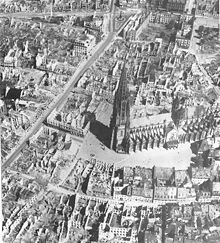
Aerial view of the bombed-out city centre with the cathedral largely undamaged despite a firestorm, after the air raid in November 1944
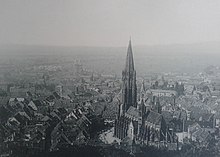
Freiburg, before 1903. photograph: Max Henry Ferrars
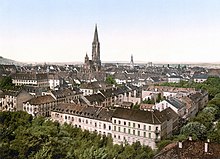
Freiburg around 1900
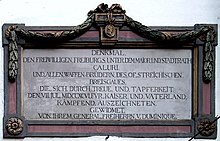
Plaque at the Martinstor in memory of the defenders of Freiburg against the French revolutionary army in 1796

Master N. J. W.: Freiburg im Breisgau, around 1580
_jm59356.jpg)
In the oldest town hall of Freiburg, the Gerichtslaube, the Reichstag took place in 1498

Four Habsburg rulers at the Historic Department Store
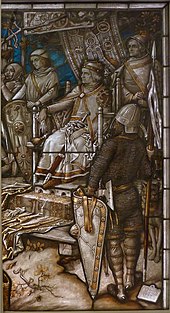
Konrad von Zähringen grants the settlement at the foot of the Schlossberg the town charter (stained glass by Fritz Geiges, 1899)
Search within the encyclopedia